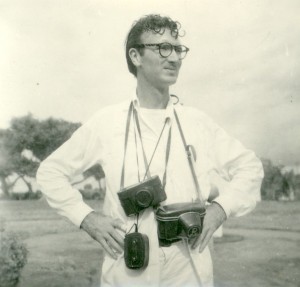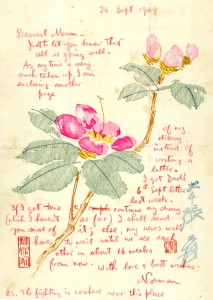The University Archives holds a collection of material relating to the Stirling-born filmmaker Norman McLaren including over 400 letters he wrote to his parents in Stirling over a 30 year period beginning in 1936. The letters were written on a regular, sometimes weekly, basis and include information on the development of his career, accounts of his travels and discussions of his work, alongside family business and personal information.
In 1949 McLaren was invited by UNESCO to travel to China to teach young Chinese artists how to make animated films as part of a project to improve the health of China’s rural population. McLaren’s adventure started pleasantly enough, travelling from his home in Ottawa, Canada, (where he worked at the National Film Board) west across the Pacific. He stopped off at Honolulu which he described in a letter to his parents as “utterly bewitching, no place for a Scot with a buried Presbyterian conscience to remain!” From the tropical paradise of Hawaii McLaren continued on to Tokyo, a city still struggling to rebuild itself in the aftermath of the Second World War. He kept a detailed journal of his trip and noted the poverty and destruction still clearly visible in Japan’s capital.

From the dust and rubble of Tokyo McLaren continued onwards to the heat and humidity of Hong Kong and into China to the small town of Pehpei in Szechuan province. Unfortunately for McLaren he arrived in China as the conflict between the Nationalists and Communists swept through the country. For several months life continued as normal in the sleepy rural town of Pehpei where McLaren got on with his job of educating his Chinese pupils. In December 1949 the Communist revolution arrived on Pehpei’s doorstep. In an article he wrote for a Canadian magazine on his return McLaren recounted the efforts made by the town’s mayor to prevent the retreating Nationalist forces from ransacking the town by welcoming them, feeding them and providing them with transport to help them on their way. With the Nationalists gone the town prepared a big welcoming show for the advancing communist troops – which had to be quickly cancelled when a further group of Nationalist soldiers appeared on the horizon! After entertaining thousands of retreating nationalist troops the town put up it’s bunting and held its breath for the victorious communist army. However the expected red army didn’t appear and the town was entered by a single truck of slightly bemused soldiers.
The arrival of the communists made McLaren’s departure difficult as the country closed its doors to the outside world. With no way home McLaren was forced to remain in Pehpei and extend the educational project. After the initial upheaval of the Communist take-over life in Pehpei appears to have returned to quiet normality. In a letter written on 22 Jan 1950 McLaren noted “life here is very quiet and simple, with little to do, little to read, and no radio.” A new regime brought new bureaucracy and it took McLaren five months to get a travel permit to leave. In March 1950 he received an official invitation from the Ministry of Culture to visit them in Peking. It was his ticket out of China. He left Pehpei and travelled across the country by train where he witnessed “many evidences of the battlefields of the past twenty years of war”. Following a brief stop-off in the capital he finally reached Hong Kong in May 1950.

Despite the conflict he witnessed and the virtual imprisonment he suffered McLaren appears to have enjoyed his time in China and gained a great respect for its people. Reflecting on his experiences he wrote, in a letter to his parents, “Chinese civilisation in many ways is superior to our recent western civilisation. I am sorry in many ways to be leaving it. It is not in its plumbing or mechanical gadgets that China is superior, but in its simple human attitudes.”